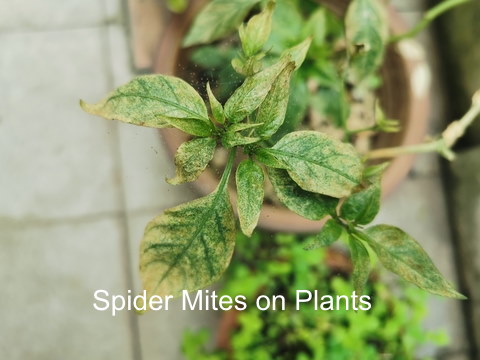How to Kill Spider Mites on Plants
Spider mites are perhaps the most dreaded of house plant pests. By the time you notice their faint webbing, the plant is seriously infested.
Mites form colonies and multiply quickly. Most eggs are female and adult females lay about 100 eggs, with eggs hatching just 3 days after they're laid. The whole lifecycle -- from egg to egg-laying adult takes only 2 weeks. If not controlled, mites can destroy a plant and then move on to nearby plants.
What They Look Like
Often called "red spider mites", they may be red, green, or yellow. Indoors, the most common is the two-spotted sider mite. But, you won't notice their spots. Mites are specks about the size of pepper flakes. And they are true spiders, not insects.
They suck plant juices with their needle-sharp mouthparts. Attacks can cause leaves to look mottled and yellow, dusty, distorted, or dry out and drop off. Uncontrolled infestation can kill a plant.
 Spider mites cause yellow speckled marks on foliage, as well as spider webs.
Spider mites cause yellow speckled marks on foliage, as well as spider webs.Where to Find Them
These eight-legged pests are so tiny, you need a magnifying glass to see them. You'll likely notice their fine webbing first. Look for webbing on the undersides of leaves and between leaves. If you tap the leaf over a sheet of white paper, you may be able to see moving specks.
Spider mites love warm (70-80°F/21-27°C), dry conditions, making heated homes in winter an ideal environment for them to thrive.
Ivy is a favorite house plant for these bugs.
Prevent an Infestation
Raise humidity. Most house plants have tropical origins and appreciate regular misting to raise the humidity around them. Misting with tepid water not only adds moisture to the air, it also discourages spider mites because they love dry conditions.
Keep it clean. A big first step in spider mite control is to keep foliage clean. Wipe off dust regularly with a damp cloth. For fine-leafed plants -- such as palms and ferns -- use a fine spray of room-temperature water from a spray bottle. Your plants will love the extra humidity, but the mites won't. Also clean gardening tools often to avoid giving pests a ride from plant to plant.
How to Kill Spider Mites on Plants
Isolate the plant and prune badly infested or damaged leaves.
Clean infested plants with a cloth or sponge dipped in soapy water. Use mild dishwashing liquid that doesn't contain fragrance or other additives. Squirt 2 teaspoonfuls into 1 gallon of room-temperature water and gently wash the plant's leaves, especially the undersides of leaves. Rinse well.
To wash the long stems of ivy, make a sinkful of soapy, room-temperature water. Swish the ivy stems through it with your hand for several minutes, then rinse thoroughly in clear room-temperature water. This should destroy any mites on the plant. Repeat in 2-3 days if necessary.
For heavy infestations, spray plant with an Insecticidal Soap
made for indoor plants. Spray every 2-3 days to break the
life cycle. It may take several applications. Make sure your plant is listed on the product label. Read the label carefully and
follow the manufacturer's directions for use.
Neem oil works great. It's proven to kill these pests and their eggs. It's an organic insecticide that's safe to use on indoor plants.
Increasing the humidity around your plant may help to prevent another invasion.


